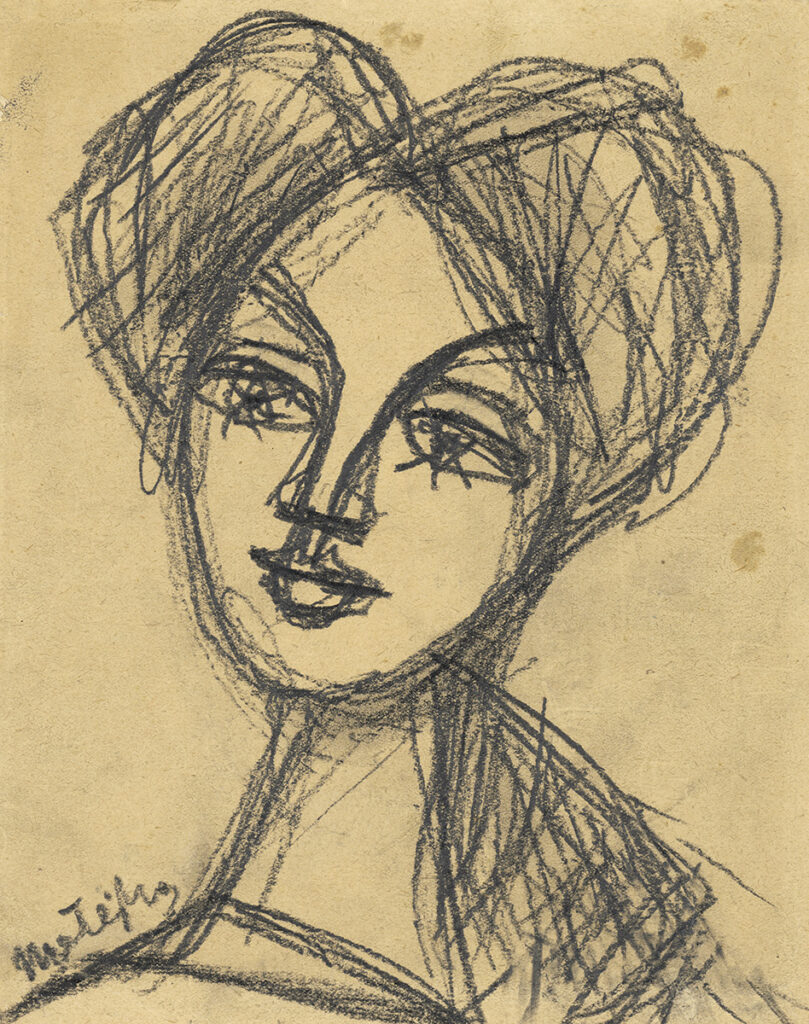Peter Matejka is usually recognised as a part of Slovak interwar fine art modernism, also known as Generation 1909, specifically its so-called “Prague branch”. Other members of Generation 1909 include Cyprián Majerník, Ján Želibský, Bedrich Hoffstädter, Štefan Bednár, Eugen Nevan, Rudolf Pribiš and other upcoming artists of the 1930s. The term itself was coined by Karol Vaculík and other curators of the Slovak National Gallery at the 1964 exhibition titled Generation 1909 – Conscience of Time. As in Eugen Nevan’s case, Matejka’s association with this group is not always unanimous. Their younger age and different theme inclinations place them somewhere between Generation 1909 and the upcoming artists of the World War II generation (such as Vincent Hložník or Ladislav Guderna).1
Matejka used to portray mostly typical genre motives like female portraits and half-figures, bouquets, still lifes or landscapes. Some of the specific features of his works are strict formal analysis, the use artistic shortcuts, reduction of colours and contrast, linear geometric flatness and distinctive black contours framing shapes and emphasising the drawing in his paintings. He connected the dramatic with the lyrical and the monumental with the subtle. Multi-figural compositions and epic narratives are hard to find in his works. The art theorist Ľubor Kára called him “…the most content-focused among the most art-focused Slovak painters”.2
From 1949 to 1956, Peter Matejka’s artistic program focused on drawings (mostly with charcoal). During this period, we can observe the artist inclined toward social realism, though it is more apparent in his choice of motives (Slovak National Uprising, the mine and miners of Handlová, agricultural themes etc.) than in the schematic or formal characteristics of the artistic doctrine. Karol Vaculík wrote: “Matejka understands painting as a standalone, final work of art with a complex composition plan… In this regard, we can consider Matejka’s painting and drawing equal.”3
After 1956, Peter Matejka returned to his earlier inspirations and the technique of oil painting. The only work by Matejkain Nitra Gallery’s collection belongs to this very period and is titled Female Head Study. The pencil drawing on paper depicts a female head with a distinctive hairstyle, captured in dramatic, expressive strokes. The face details, especially her sharp nose, big eyes and thick eyebrows remind us of Matejka’s works from the second half of the 1940s, e.g. Girl’s Head or Country Girl’s Head, both from 1947. By comparing the basic elements of the Female Head Study with Matejka’s paintings from the second half of the 1950s, such as Female Student from 1956 or Female Artistefrom 1958, we get the opportunity to observe how he returns from his brief visit of social realism, but also perfects his artistic expression and moves toward a next chapter of his career. It is possible that Matejka used drawings, such as the one in Nitra Gallery’s collection, as groundworks for his new painting endeavours.4
Peter Matejka was born June 26, 1913 in Nové Mesto and Váhom. After attending elementary school, he became an apprentice painter. From 1934 to 1935, he attended the Academy of Ukraine in Prague and from 1935 to 1939, he studied the Academy of Fine Arts in Prague under professor Willy Nowak. In 1940, he returned to his hometown and moved to Bratislava in 1945. In 1940, he became a member of the Slovak Artists Association and after 1945, he worked as a member of the Slovak Art Life Reorganisation Committee. Until 1948, he was also a member of the Arts and Science Council. He was one of the initiators responsible for founding the Slovak National Gallery, the Academy of Fine Arts and Design and other art institutions. He was one of the founding members of the 29th August Artists Group and from 1949, he was also a member of the Art Forum in Prague. From 1950 to 1972, he taught at the Academy of Fine Arts and Design in Bratislava where he became an Associate Professor in 1954, a Professor and the head of the Department of Monumental Painting in 1966. He died suddenly on February 10, 1972 in Bratislava.
—Omar Mirza, July 2020
Sources
1 For more on Matejka and Generation 1909 see: KÁRA, Ľubor: Peter Matejka. Bratislava : Vydavateľstvo Slovenského fondu výtvarných umení, 1963, p. 10 – 12.
2 ibid, p. 26.
3 VACULÍK, Karol: Peter Matejka. Bratislava : Slovenské vydavateľstvo krásnej literatúry, 1960, p. 32 – 37.
4 Compare: ibid, p. 37.
Inventory No.: K 237
Artist: Peter Matejka
Title: Female Head Study
Dating: 1956 – 1960
Technique: pencil
Material: paper
Dimensions: height 23 cm; width 19 cm
Signature: bottom left, in pencil: Matejka
